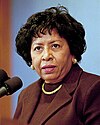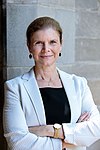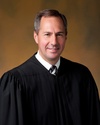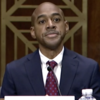Supreme Court of Zamastan
| Supreme Court of Zamastan | |
|---|---|
 | |
| Established | September 27, 1804 |
| Location | Tofino, Zian |
| Composition method | Presidential nomination with Senate confirmation |
| Authorized by | Constitution of Zamastan |
| Judge term length | Life tenure |
| Number of positions | 9 (by statute) |
| Chief Justice of Zamastan | |
| Currently | Roosevelt Dunn |
The Supreme Court of Zamastan (SCOZ) is the highest court in Zamastan. It has ultimate (and largely discretionary) appellate jurisdiction over all federal and state court cases that involve a point of federal law, and original jurisdiction over a narrow range of cases, specifically "all Cases affecting Ambassadors, other public Ministers and Consuls, and those in which a State shall be Party". The Court holds the power of judicial review, the ability to invalidate a statute for violating a provision of the Constitution. It is also able to strike down presidential directives for violating either the Constitution or statutory law. However, it may act only within the context of a case in an area of law over which it has jurisdiction. The Court may decide cases having political overtones, but it has ruled that it does not have power to decide non-justiciable political questions.
Established by Article III of the Constitution, the composition and procedures of the Supreme Court were initially established by the 1st Congress through the Judiciary Act of 1804. The Court consists of the chief justice and eight associate justices. Each justice has lifetime tenure, meaning they remain on the Court until they resign, retire, die, or are removed from office. When a vacancy occurs, the President, with the advice and consent of the Senate, appoints a new justice. Each justice has a single vote in deciding the cases argued before it. When in majority, the chief justice decides who writes the opinion of the court; otherwise, the most senior justice in the majority assigns the task of writing the opinion.
The Court meets in the Supreme Court Building in Tofino, Zian.
History
Earliest beginnings through George
From Holland to Beach
Gaviria Era
Modern Court
Composition
Size of the court
Article III of the Constitution sets neither the size of the Supreme Court nor any specific positions on it (though existence of the office of chief justice is tacitly acknowledged in Article I, Section 3, Clause 6). Instead, these powers are entrusted to Congress.
Appointment and confirmation
The president to nominate and, with the confirmation (advice and consent) of the Senate, to appoint public officials, including justices of the Supreme Court. This clause is one example of the system of checks and balances inherent in the Constitution. The president has the plenary power to nominate, while the Senate possesses the plenary power to reject or confirm the nominee. The Constitution sets no qualifications for service as a justice, thus a president may nominate anyone to serve, and the Senate may not set any qualifications or otherwise limit who the president can choose.
Membership
See: List of justices of the Supreme Court of Zamastan
Current justices
The Supreme Court consists of a chief justice, currently Roosevelt Dunn, and eight associate justices. Among the current members of the Court, Humphrey Bullock is the longest-serving justice, with a tenure of 14,874 days (40 years, 264 days) as of December 23, 2024; the most recent justice to join the court is Aaron Fitmann, whose tenure began on July 12, 2021, with the passing of Benn Burgess on May 29th, 2021. There are seven men and two women on the court as of 2022.
| Justice / birthdate and place |
Appointed by (party) | SCV | Age at | Start date / length of service |
Succeeded | ||
|---|---|---|---|---|---|---|---|
| Start | Present | ||||||

|
(Chief Justice) Roosevelt Dunn November 13, 1952 Duncan, Pahl |
Abram Mullen (GLP) |
87-17 | 46 | 72 | September 13, 1999 25 years, 101 days |
Percy Gardnerson |

|
Humphrey Bullock October 25, 1931 Alberni, Jade |
Cassious Castovia (BCP) |
92-12 | 53 | 93 | April 3, 1984 40 years, 264 days |
Arthur O. Ridge |

|
Atticus Dougherty October 16, 1942 Vernon, Zian |
Cassious Castovia (BCP) |
78-36 | 46 | 82 | April 18, 1989 35 years, 249 days |
Carl Letten |

|
Kacper Hogg April 30, 1946 Maple Canal, Zian |
Josiah Elliott (GLP) |
99-5 | 43 | 78 | January 26, 1990 34 years, 332 days |
Jon Honiman |

|
Shona French July 3, 1945 Saint John, Northern Isle |
Camren Ellison (GLP) |
83-21 | 56 | 79 | November 23, 2001 23 years, 30 days |
Albert Hane Griffin |

|
Julie Beaumont July 19, 1952 Aurelia, Titania |
Cassious Castovia (BCP) |
84-20 | 54 | 72 | February 5, 2007 17 years, 322 days |
Angela Eurenno |

|
Isaiah Mccormack October 11, 1961 Irocarres, Lyonnais |
Cassious Castovia (BCP) |
58-46 | 54 | 63 | October 20, 2015 9 years, 64 days |
Man Brennan |

|
Abdallah Gilmour November 4, 1983 Pemberton, Jade |
Anya Bishop (BCP) |
69-35 | 35 | 41 | May 12, 2019 5 years, 225 days |
Bernice Matthis |

|
Aaron Fitmann March 14, 1965 Salland, Tregueux |
Atticus Moreau (BM) |
64-40 | 56 | 59 | July 12, 2021 3 years, 164 days |
Benn Burgess |
Former justices
- Benn Burgess; Joined October 23rd, 1981, died May 29th, 2021 (39 years and 218 days)
Salary
As of 2021, associate justices receive a yearly salary of Z$208,300 and the chief justice is paid Z$250,500 per year. The 23rd Amendment of the Constitution of Zamastan prohibits Congressional Hall from reducing the pay for incumbent justices on the Supreme Court.
Facilities
